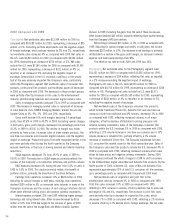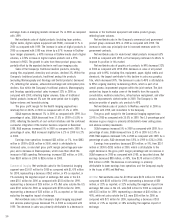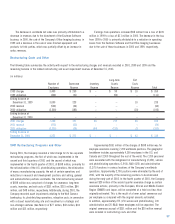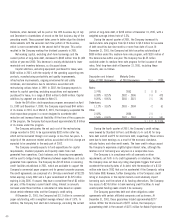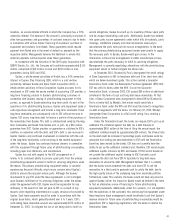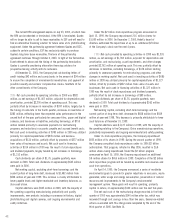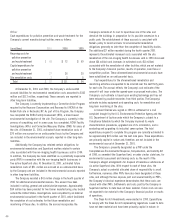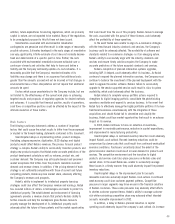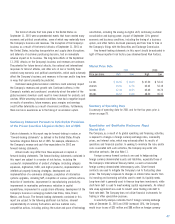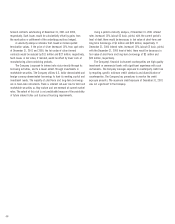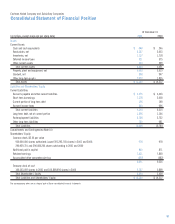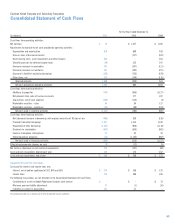Kodak 2001 Annual Report Download - page 46
Download and view the complete annual report
Please find page 46 of the 2001 Kodak annual report below. You can navigate through the pages in the report by either clicking on the pages listed below, or by using the keyword search tool below to find specific information within the annual report.
44
Other
Cash expenditures for pollution prevention and waste treatment for the
Company’s current manufacturing facilities were as follows:
(in millions) 2001 2000 1999
Recurring costs for
pollution prevention
and waste treatment $68 $72 $69
Capital expenditures for
pollution prevention
and waste treatment 27 36 20
Site remediation costs 235
Total $97 $111 $ 94
At December 31, 2001 and 2000, the Company’s undiscounted
accrued liabilities for environmental remediation costs amounted to $162
million and $113 million, respectively. These amounts are reported in
other long-term liabilities.
The Company is currently implementing a Corrective Action Program
required by the Resource Conservation and Recovery Act (RCRA) at the
Kodak Park site in Rochester, NY. As part of this Program, the Company
has completed the RCRA Facility Assessment (RFA), a broad-based
environmental investigation of the site. The Company is currently in the
process of completing, and in some cases has completed, RCRA Facility
Investigations (RFIs) and Corrective Measures Studies (CMS) for areas at
the site. At December 31, 2001, estimated future remediation costs of
$70 million are accrued on an undiscounted basis by the Company and
are included in the environmental accruals reported in other long-term
liabilities.
Additionally, the Company has retained certain obligations for
environmental remediation and Superfund matters related to certain
sites associated with the non-imaging health businesses sold in 1994.
In addition, the Company has been identified as a potentially responsible
party (PRP) in connection with the non-imaging health businesses in
five active Superfund sites. At December 31, 2001, estimated future
remediation costs of $51 million are accrued on an undiscounted basis
by the Company and are included in the environmental accruals reported
in other long-term liabilities.
The Company recorded a $41 million charge in the fourth quarter of
2001 for additional environmental reserves. This amount has been
included in selling, general and administrative expenses. Approximately
$34 million has been provided for two former manufacturing sites located
outside the United States. Investigations were completed by an external
environmental consultant in the fourth quarter of 2001, which facilitated
the completion of cost estimates for the future remediation and
monitoring of these sites. In addition, the accrual incorporates the
Company’s estimate of its cost to repurchase one of the sites and
demolish the buildings in preparation for its possible conversion to a
public park. The establishment of these accruals is consistent with
Kodak’s policy to record accruals for environmental remediation
obligations generally no later than the completion of feasibility studies.
The additional $7 million recorded during the fourth quarter 2001
represents the estimated increased costs associated with the site
remediation of the non-imaging health businesses sold in 1994 discussed
above ($4 million) and increases in estimated costs ($3 million)
associated with the remediation of other facilities which are not material
to the Company’s financial position, results of operation, cash flows or
competitive position. These aforementioned environmental accruals have
been established on an undiscounted basis.
Cash expenditures for the aforementioned remediation and
monitoring activities are expected to be incurred over the next thirty years
for each site. The accrual reflects the Company’s cost estimate of the
amount it will incur under the agreed-upon or proposed work plans. The
Company’s cost estimate is based upon existing technology and has not
been reduced by possible recoveries from third parties. The Company’s
estimate includes equipment and operating costs for remediation and
long-term monitoring of the sites.
A Consent Decree was signed in 1994 in settlement of a civil
complaint brought by the U.S. Environmental Protection Agency and the
U.S. Department of Justice under which the Company is subject to a
Compliance Schedule by which the Company improved its waste
characterization procedures, upgraded one of its incinerators, and is
evaluating and upgrading its industrial sewer system. The total
expenditures required to complete this program are currently estimated to
be approximately $24 million over the next nine years. These expenditures
are primarily capital in nature and, therefore, are not included in the
environmental accrual at December 31, 2001.
The Company is presently designated as a PRP under the
Comprehensive Environmental Response, Compensation, and Liability Act
of 1980, as amended (the Superfund law), or under similar state laws, for
environmental assessment and cleanup costs as the result of the
Company’s alleged arrangements for disposal of hazardous substances at
six active Superfund sites. With respect to each of these sites, the
Company’s actual or potential allocated share of responsibility is small.
Furthermore, numerous other PRPs have also been designated at these
sites, and although the law imposes joint and several liability on PRPs,
the Company’s historical experience demonstrates that these costs are
shared with other PRPs. Settlements and costs paid by the Company in
Superfund matters to date have not been material. Future costs are also
not expected to be material to the Company’s financial position or results
of operations.
The Clean Air Act Amendments were enacted in 1990. Expenditures
to comply with the Clean Air Act implementing regulations issued to date
have not been material and have been primarily capital in nature. In


